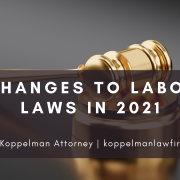Changes to Labor Laws in 2021
2020 has seen the quick passage of multiple labor and employment laws that will go into effect starting January 1, 2021. For human resource departments all over the nation, there is a flurry of organization needed as departments get their companies up to speed. New laws will be covering pandemic relief measures and temporary I-9 verification changes, among others. The penalty for non complying with collective bargaining agreements (CBAs), employment laws, and safety regulations for workers brings with it a bunch of legal issues. Brand reputations can be affected, along with employee retention rates and satisfaction and morale in the workplace.
Predictive scheduling ordinances for 2021 will enforce companies to schedule their workers 10 days in advance, with an increase to 14 days in 2022. Many hourly employees are excited about this change. This gives them more flexibility in their work-life balance, which is the key to keeping morale boosted. Humans need to be able to have a social life and work-life that are independent of each other. Other advantages to this new law will ensure that companies offer predictable pay if a change is made to the schedule later on, and giving employees the freedom to decline those modifications at the last minute. In addition, employers are responsible for giving workers adequate time off between working shifts. All scheduling records must be saved for a specified period of time as well.
Perhaps the most exciting change to come along for part-time workers is the upcoming change to the minimum wage. The Department of Labor shows that the standard rate of $7.25 has remained unchanged 2009. Starting January 1, 2021, 25 states have already pledged to raise the rate in their states to compete in a tight job market. The figures vary by state along with the cost of living. The Department of Labor (DOL) state minimum wage law page has a searchable interactive map of which states are participating.
Another announcement pertaining to 2021 comes from The Department of Labor’s Occupational Safety and Health Administration (OSHA). They have been working diligently to supply answers to all the influx of COVID-19-related questions about employee protection as we enter the disease’s second year.












